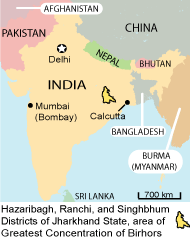The degradation and disappearance of the natural forest cover in India has severely affected the economic subsistence of the Birhor. A recent journal article analyzes historical reports about that society, the Indian census records from 1961 through 1991, and field research in 1999 to derive a portrait of the changes in Birhor economic activities over the past 100 years. The most significant factor affecting their lives is the extent and quality of the forests where they live.
Sohel Firdos, in a recent article published in the Economic and Political Weekly from Mumbai (Bombay), points out that a description of the Birhor in the 1920s records that their primary mode of subsistence was hunting. Over the next 40 years, published sources indicate they had shifted to hunting and rope making, which suggests to the author that the degradation of their environment had forced them to modify their traditional forest-based hunting and gathering lifestyle. More recent literature implies that rope-making had become their primary economic activity, supplemented by hunting, by the 1980s.
The author analyzes the detailed census reports from India for 1961, 1971, 1981, and 1991 to gain further insights into the Birhor subsistence patterns during the latter part of the 20th century. Curiously, the patterns seemed to change decade by decade, influenced, perhaps, by changing government policies and economic forces. From 1961 to 1971, the proportion of Birhor making their livelihood from rope-making declined from 53 percent to 37 percent, while those working in agriculture grew from 12 to 31 percent.
The patterns changed during the next decade, however. Birhor engaged in agriculture declined from 31 to 23 percent, those involved in rope-making stayed just about the same, and those working in forestry and raising livestock increased from 9 to 16 percent. But trends changed again in the decade from 1981 to 1991, when the share of Birhors engaged in rope making again plummeted, from 36 to 11 percent. During that decade, the percent of Birhors engaged primarily in food gathering also dropped from 15 percent to 4 percent.
 But their struggle to survive continues. The author found during his field research in 1999 that the Birhor once again are going back to rope making for their primary subsistence activity. The Bihar state government (as of 2000, Jharkhand state) had encouraged them to engage in farming by giving families small tracts of land, seeds, and pairs of bullocks. But the infertility of the rocky land they were given, plus their own lack of agricultural expertise, led them to abandon the effort and revert to what they know best—rope making. The author found that in 1999, 72 percent of them were once more engaged in making ropes for a living, though since their traditional Bahunia vines are virtually gone, they either have to buy jute and process it into ropes, or they make ropes from materials supplied by customers.
But their struggle to survive continues. The author found during his field research in 1999 that the Birhor once again are going back to rope making for their primary subsistence activity. The Bihar state government (as of 2000, Jharkhand state) had encouraged them to engage in farming by giving families small tracts of land, seeds, and pairs of bullocks. But the infertility of the rocky land they were given, plus their own lack of agricultural expertise, led them to abandon the effort and revert to what they know best—rope making. The author found that in 1999, 72 percent of them were once more engaged in making ropes for a living, though since their traditional Bahunia vines are virtually gone, they either have to buy jute and process it into ropes, or they make ropes from materials supplied by customers.
The heart of the paper is the author’s district-by-district analysis, based on details provided by the four censuses, of changes in the Birhor population and the declining amounts of forest cover. He concludes that the Birhor populations are declining in districts where the forests are disappearing, because they are migrating to other districts where the forests, even if they are degraded, remain. In other words, they would rather move to a new district where they can live in or near a woodland than continue to exist in the almost intolerable situation of living without a forest nearby.
Their self-identity—their name “Birhor” means “men of the forest” according to Adhikary (1984b)—is obviously still very important to them. Although Firdos does not suggest it, perhaps their rope-making, now fabricated with non-forest fibers, also helps them retain a sense of their former connection with the forests. After many decades of changes, the Birhor love for their natural environment is still evident through the scholarship of this paper.
Firdos, Sohel. 2005. “ Forest Degradation, Changing Workforce Structure and Population Redistribution: The Case of Birhors in Jharkhand.” Economic and Political Weekly 40 (8), February 19, 2005: 773-778.